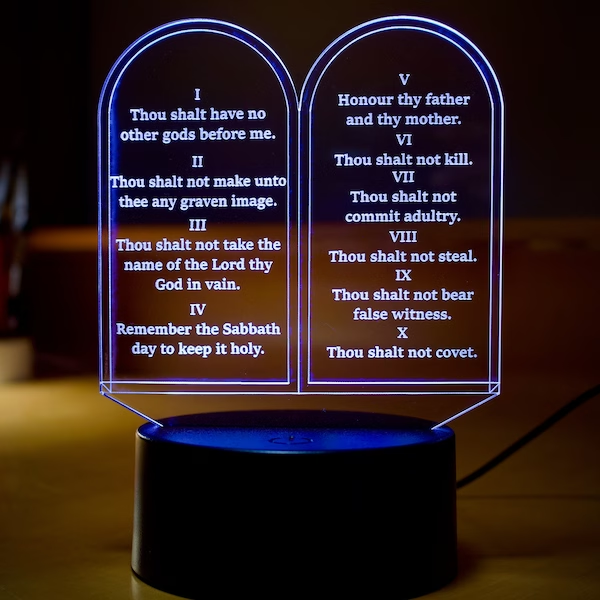The question of whether public schools should teach religious content, particularly the Ten Commandments, has sparked a heated debate across the United States. Some argue that this religious text provides valuable moral guidance for students, while others raise concerns about the separation of church and state. As more and more districts face this issue, it’s essential to understand the various viewpoints and the potential implications for the future of education.
1. What Are the Ten Commandments?

The Ten Commandments, a set of moral and religious principles, originate from the Bible, specifically the book of Exodus. These guidelines cover a range of ethical topics, such as honoring one’s parents, refraining from stealing, and refraining from killing. While the Ten Commandments are central to many religious beliefs, their role in public education has become a matter of controversy.
2. Why Is the Debate About the Ten Commandments in Schools Growing?
The debate over religious content in schools has intensified in recent years, particularly following the push for more inclusive and diverse curriculums. Several factors have contributed to the growing discussions surrounding the Ten Commandments:
- The Rise of Religious Communities: As different religious communities become more active in advocating for their values, questions about whether their beliefs should be included in public education are becoming more common.
- Legal Challenges and Court Rulings: Several court cases have challenged the inclusion of religious texts in public schools, including rulings that have focused on the constitutional principle of the separation of church and state.
- Moral Education and Character Development: Proponents of teaching the Ten Commandments argue that they provide a strong moral framework that can help shape students’ character and decision-making skills.
3. The Arguments for Teaching the Ten Commandments

Supporters of teaching the Ten Commandments in public schools believe that these principles offer timeless guidance. Their arguments often focus on the following points:
- Building Strong Moral Values: Many supporters argue that teaching the Ten Commandments can help students develop a strong sense of morality and ethics. These principles, such as not lying, stealing, or killing, are seen as universal values that can guide students in their everyday lives.
- Fostering Religious Understanding: Some believe that understanding the Ten Commandments is essential for students to comprehend the history and cultural significance of various religious traditions. By studying these teachings, students may develop a more inclusive and tolerant worldview.
- Encouraging Character Development: Advocates suggest that exposure to religious texts can play a crucial role in shaping students’ character and encouraging positive behavior both in and outside the classroom.
- Civic Responsibility and Social Harmony: Another argument is that teaching the Ten Commandments promotes social cohesion and civic responsibility. By instilling a sense of ethical duty in students, supporters believe that schools can contribute to the greater good of society.
4. The Case Against Teaching the Ten Commandments in Schools
On the other hand, opponents of incorporating religious texts like the Ten Commandments into public school curricula raise several key concerns:
- Separation of Church and State: One of the central tenets of the U.S. Constitution is the principle of separation of church and state. Critics argue that allowing religious teachings in public schools violates this principle and could lead to government endorsement of a particular religion.
- Religious Freedom and Diversity: America is home to people of diverse religious backgrounds, and opponents fear that teaching the Ten Commandments could alienate students from non-Christian faiths or those who do not follow any religion at all. They worry that public schools should remain neutral to avoid imposing religious beliefs on students.
- Potential for Exclusion and Bias: Critics argue that emphasizing a specific religious text may lead to exclusionary practices or bias. If the Ten Commandments are taught, students from various religious traditions may feel marginalized or disregarded in favor of a particular belief system.
- Legal Precedents and Court Rulings: Previous court rulings have found that public schools cannot endorse religious practices or teachings, including the display of the Ten Commandments in classrooms. These rulings emphasize the importance of keeping public education secular and preventing religious indoctrination.
5. Historical Context: The Role of Religion in American Education
To understand the current debate, it’s important to look back at the history of religious content in U.S. public schools. Religion has played a role in American education from the early days of the country. For instance:
- Early Education and Religious Texts: In the 18th and 19th centuries, many public schools used religious texts, including the Bible, as part of their curriculum. The Ten Commandments were often taught alongside other moral guidelines.
- The Establishment Clause and Court Cases: In the 20th century, the legal landscape shifted, especially with the advent of the Establishment Clause of the First Amendment. Landmark court cases, such as Engel v. Vitale (1962) and Stone v. Graham (1980), reinforced the idea that religious activities, including the teaching of religious texts, should not take place in public schools.

6. Recent Cases and Controversies Over Religious Content in Schools
Over the past few decades, several high-profile cases have ignited debates about religious content in public education. Here are a few examples:
- The Alabama Ten Commandments Monument Case (2003): A large monument of the Ten Commandments was placed in the Alabama State Judicial Building, leading to legal challenges based on the First Amendment. The case eventually led to the monument’s removal, with the courts ruling that the display violated the constitutional principle of separation of church and state.
- Religious Texts in School Curricula: Some school districts have attempted to introduce religious texts, including the Ten Commandments, into their curriculum. These efforts often lead to controversy and legal challenges from parents, civil rights groups, and religious organizations.
- Current Efforts for Reform: As debates continue, some school districts are pushing for reforms that would allow for the inclusion of religious content in history and social studies classes. These initiatives often aim to promote understanding of religious diversity rather than endorse any specific faith.
7. What Do Parents and Students Think?
As the debate continues, public opinion on this matter remains divided. Surveys show that opinions vary depending on religious background, political views, and geographical location.
- Parents’ Perspectives: Some parents strongly support the idea of teaching the Ten Commandments, believing that it would instill moral values in their children. Others oppose it, fearing that it would compromise the secular nature of public education.
- Students’ Experiences: Students’ experiences with religious content in schools also vary. In some cases, students report feeling more connected to the material and their cultural roots. In other cases, students feel uncomfortable or excluded when religious teachings are emphasized in a public setting.
8. What Could the Future Hold for Religious Content in Schools?
The future of teaching the Ten Commandments in schools remains uncertain. The ongoing debate is likely to continue as legal rulings evolve and public attitudes shift. Key factors that could influence the future of religious content in schools include:
- Changes in Legal Precedents: As new court cases emerge, legal interpretations of the First Amendment may evolve. Future rulings could provide greater clarity on the permissibility of religious content in schools.
- Educational Reforms: School boards and educators may seek new ways to incorporate religious and moral teachings into curricula while adhering to constitutional guidelines. These efforts could focus on promoting religious literacy and tolerance.
- Public Opinion and Advocacy: Public opinion and lobbying efforts from religious and secular organizations will continue to shape the debate. The outcome may depend on how strongly different groups advocate for their positions.
Conclusion: Striking a Balance Between Education and Religion
The debate over teaching the Ten Commandments in public schools is part of a larger conversation about the role of religion in education. While some argue that religious texts offer valuable moral guidance, others believe that such teachings have no place in a secular public school system. As the debate continues, it’s crucial to find a balance that respects both the constitutional principles of church and state and the need for comprehensive, inclusive education.
By engaging in thoughtful discussions, we can work toward a solution that upholds the values of religious freedom, inclusivity, and educational integrity for all students.
Neurological Enhancements: Advancements in Brain Augmentation Technologies






